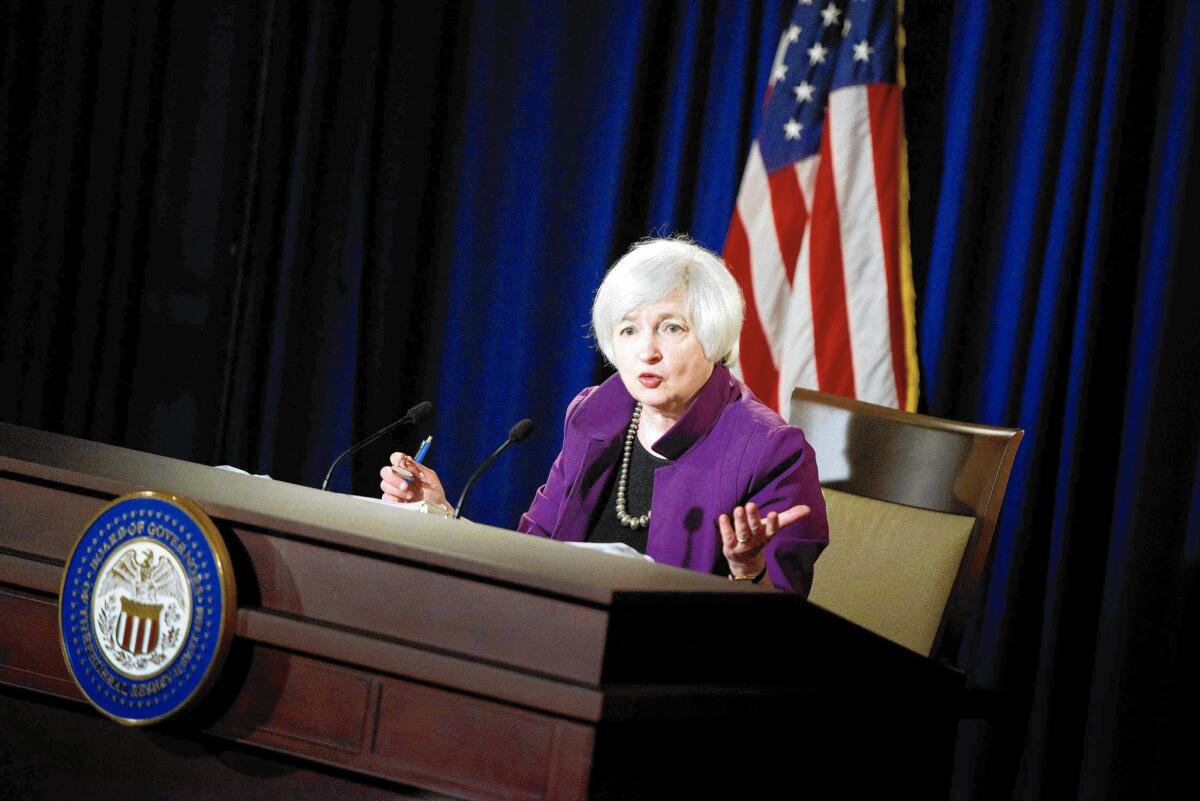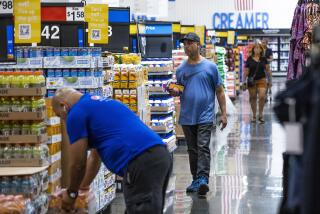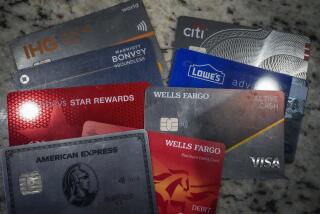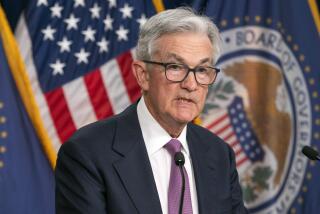Fed downgrades its economic outlook but expects a rate hike this year

Federal Reserve policymakers sharply downgraded their view of the economy — forecasting the weakest annual growth since 2011 — but indicated they were on track to raise a key interest rate in the coming months.
“It’s not an ironclad guarantee, but we anticipate that that’s something that will be appropriate later this year,” Fed Chairwoman Janet L. Yellen told reporters Wednesday.
Fed policymakers had said they could raise the short-term federal funds rate, a benchmark that affects mortgage and other lending and savings rates, as early as this month if economic data warranted it.
Such a move, the first hike since 2006, would signal the economy was strong enough for the Fed to start ratcheting up the unprecedented low rate put in place to help combat the Great Recession and spur the recovery.
“I believe a decision to raise rates would signify very clearly that the U.S. economy has made great progress in recovering from the trauma of the financial crisis and that we’re in a different place,” Yellen said.
But after wrapping up a two-day meeting, central bank policymakers decided the economy was not yet in that place.
They opted to keep the rate near zero, where it has been since late 2008 in an attempt to boost economic growth by making the cost of borrowing money cheaper and increasing incentives to spend rather than save.
Still, Yellen and her colleagues were clear: A rate hike is coming. Of the 17 participants in the Fed’s meeting, 15 said they expected a rate increase this year.
With a downgrade in projected economic growth, though, more Fed officials are expecting a slower pace of increases. In their new projection, seven of the 17 policymakers forecast the rate would be raised no more than once this year. In March, just three officials were in that camp.
“The center of gravity at the Fed is undecided whether they start in September or December,” said Josh Feinman, managing director at Deutsche Asset Management in New York and a former Fed global market economist.
Those are the months for the next two meetings that include a Yellen news conference, and many Fed watchers believe the central bank will raise the rate only when she has an opportunity to go before TV cameras and explain the action.
Some economists argue that the Fed might be waiting too long to raise the rate and could be sowing the seeds of more bubbles in the economy.
Yellen acknowledged that the Fed probably should have raised interest rates more aggressively in the middle of the last decade, but apart from sounding a cautionary note about stock prices, she has not expressed concerns about asset values and doesn’t want to risk squelching a recovery that has been uneven and moderate.
Carl Tannenbaum, senior vice president at Northern Trust Co. in Chicago, forecasts the first rate hike of 0.25 percentage point in September and then another one like it in December, followed by similar quarter-point increases every other meeting in 2016.
“It isn’t so much the date of liftoff but the trajectory of the orbit that investors care about,” he said.
Investors appeared relieved that the Fed didn’t raise the rate Wednesday and signaled it would rise slower than previously estimated. The Dow Jones industrial average jumped nearly 100 points as Yellen spoke before giving back much of the gains. The Dow gained 31.26 points, or about 0.2%, to 17,935.74.
Hopes for a breakout year for economic growth were dashed this winter when the economy shrank at a 0.7% annual rate. Economists said the quarterly contraction, the third since the recession ended in 2009, was driven in large part by unusually bad winter weather and the labor dispute at West Coast ports.
Economic conditions have improved in recent weeks, but the winter’s slowdown caused damage. Fed policymakers projected the economy would grow only 1.8% to 2% this year, well below the range of 2.3% to 2.7% in its March forecast.
Yellen said she and her colleagues view the first quarter’s disappointing economic performance as “largely transitory.” But she said they “would like to see more decisive evidence that a moderate pace of economic growth will be sustained.”
Although the housing market “has shown some improvement,” Fed officials said exports and investments by businesses have been weak.
Central bank policymakers were less optimistic about improvements in the unemployment rate than they were three months ago, though they noted that the pace of job gains had improved.
They forecasted that the unemployment rate, which was 5.5% in May, would drop to no lower than 5.2% by the end of the year. In March, they saw the jobless rate dropping to as low as 5% this year.
Annual inflation, slowed largely by declining oil prices, is expected to be 0.6% to 0.8% this year — the same as predicted in March. That’s well below the Fed’s 2% target.
Given the slow start to the year and the low inflation, many analysts had expected the Fed would not raise rates until at least September. Some economists have said they didn’t think the Fed would raise the rate until next year.
This month, officials at the International Monetary Fund and the World Bank called on the Fed to wait until at least next year to start raising its benchmark rate out of concerns an increase could slow U.S. growth and roil the global economy.
Yellen stressed that the Fed plans to raise rates slowly to avoid damaging the economy.
Although waiting too long to raise rates could cause inflation to jump, she said, “beginning too early could risk derailing a recovery that we’ve worked for a very long time to try to achieve.”
IHS chief economist Nariman Behravesh expects the first rate increase in September.
“It is almost as though the Fed wants to get the first rate hike out of the way,” he said. “After that, it will take its time and will only gradually tighten monetary conditions further.”
More to Read
Inside the business of entertainment
The Wide Shot brings you news, analysis and insights on everything from streaming wars to production — and what it all means for the future.
You may occasionally receive promotional content from the Los Angeles Times.












